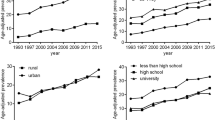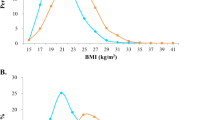Abstract
Background/objectives:
Little is known about whether waist circumference (WC) has increased disproportionately relative to body mass index (BMI) around the world.
Subjects/methods:
Data came from the US National Health and Nutrition Examination Survey (1988–1994 and 2007–2010), Health Survey for England (1992–1993 and 2008–2009); the Mexican Nutrition Survey (1999) and the Mexican National Health and Nutrition Survey (NHNS 2012); and the China Health and Nutrition Survey (1993 and 2011). Country- and sex-stratified (for the United States, also race-/ethnicity-stratified) multivariable linear regressions were used to estimate mean difference in WC over time relative to BMI at specified overweight and obesity cutoff points, adjusting for age and survey year.
Results:
Although mean WC and BMI shifted upward over time in all age–sex subpopulations in all four countries, trends in overweight prevalence were less consistent. However, WC relative to BMI increased at varying magnitudes across all countries and subpopulations, except US Black men. The magnitude of increase was largest for women in the youngest age group (20–29 years), particularly for women in Mexico (+6.6 cm, P<0.0001) and China (+4.6 cm, P<0.0001) (holding BMI constant at 25 kg/m2). For men, the increase was primarily evident among Chinese men (+4.8 cm, P<0.0001).
Conclusions:
WC has increased disproportionately over time relative to overall body mass across the United States, England, Mexico and China, particularly among young women, with the largest increases occurring in the middle-income countries of Mexico and China. These patterns are potentially a cause for concern especially for countries undergoing rapid economic and nutritional transitions.
This is a preview of subscription content, access via your institution
Access options
Subscribe to this journal
Receive 12 print issues and online access
$259.00 per year
only $21.58 per issue
Buy this article
- Purchase on Springer Link
- Instant access to full article PDF
Prices may be subject to local taxes which are calculated during checkout

Similar content being viewed by others
References
Finucane MM, Stevens GA, Cowan MJ, Danaei G, Lin JK, Paciorek CJ et al. National, regional, and global trends in body-mass index since 1980: systematic analysis of health examination surveys and epidemiological studies with 960 country-years and 9·1 million participants. Lancet 2011; 377: 557–567.
Razak F, Corsi DJ, Subramanian SV . Change in the body mass index distribution for women: analysis of surveys from 37 low- and middle-income countries. PLoS Med 2013; 10: e1001367.
Olds TS . One million skinfolds: secular trends in the fatness of young people 1951–2004. Eur J Clin Nutr 2009; 63: 934–946.
Popkin BM, Slining MM . New dynamics in global obesity facing low- and middle-income countries. Obes Rev 2013; 14: 11–20.
Stern D, Smith LP, Zhang B, Gordon-Larsen P, Popkin BM . Changes in waist circumference relative to body mass index in Chinese adults, 1993-2009. Int J Obes (Lond) 2014; 38: 1503–1510.
Albrecht SS, Barquera S, Popkin BM . Exploring secular changes in the association between BMI and waist circumference in Mexican-origin and white women: a comparison of Mexico and the United States. Am J Hum Biol 2014; 26: 627–634.
Despres JP . Abdominal obesity and cardiovascular disease: is inflammation the missing link? Can J Cardiol 2012; 28: 642–652.
Despres JP, Lemieux I, Bergeron J, Pibarot P, Mathieu P, Larose E et al. Abdominal obesity and the metabolic syndrome: contribution to global cardiometabolic risk. Arterioscler Thromb Vasc Biol 2008; 28: 1039–1049.
World Cancer Research Fund/American Institute for Cancer Research Food, Nutrition, Physical Activity, and the Prevention of Cancer: a Global Perspective. AICR: Washington, DC, USA, 2007.
Deurenberg P, Deurenberg-Yap M, Guricci S . Asian are different from Caucasians and from each other in their body mass index/body fat percent relationship. Obes Rev 2002; 3: 141–146.
World Health Organisation, International Association for the Study of Obesity, International Obesity TaskForce The Asia-Pacific Perspective: Redefining Obesity and its Treatment. Health Communications: Sydney, NSW, Australia, 2000.
Fernandez JR, Heo M, Heymsfield SB, Pierson RN Jr., Pi-Sunyer FX, Wang ZM et al. Is percentage body fat differentially related to body mass index in Hispanic Americans, African Americans, and European Americans? Am J Clin Nutr 2003; 77: 71–75.
Aleman Mateo H, Lee SY, Javed F, Thornton J, Heymsfield SB, Pierson RN et al. Elderly mexicans have less muscle and greater total and truncal fat compared to African-Americans and Caucasians with the same BMI. J Nutr Health Aging 2009; 13: 919–923.
Casas YG, Schiller BC, DeSouza CA, Seals DR . Total and regional body composition across age in healthy Hispanic and white women of similar socioeconomic status. Am J Clin Nutr 2001; 73: 13–18.
Flegal KM, Shepherd JA, Looker AC, Graubard BI, Borrud LG, Ogden CL et al. Comparisons of percentage body fat, body mass index, waist circumference, and waist-stature ratio in adults. Am J Clin Nutr 2009; 89: 500–508.
Olivares J, Wang J, Yu W, Pereg V, Weil R, Kovacs B et al. Comparisons of body volumes and dimensions using three-dimensional photonic scanning in adult Hispanic-Americans and Caucasian-Americans. J Diabetes Sci Technol 2007; 1: 921–928.
Wei M, Gaskill SP, Haffner SM, Stern MP . Waist circumference as the best predictor of noninsulin dependent diabetes mellitus (niddm) compared to body mass index, waist/hip ratio and other anthropometric measurements in Mexican Americans–a 7-year prospective study. Obes Res 1997; 5: 16–23.
Mamtani M, Kulkarni H, Dyer TD, Almasy L, Mahaney MC, Duggirala R et al. Waist circumference independently associates with the risk of insulin resistance and type 2 diabetes in Mexican American families. PLoS One 2013; 8: e59153.
Centers for Disease Control and Prevention (CDC) 2014. National health and nutrition examination survey. Available at: http://www.cdc.gov/nchs/nhanes.htm.
Mindell J, Biddulph JP, Hirani V, Stamatakis E, Craig R, Nunn S et al. Cohort profile: the health survey for England. Int J Epidemiol 2012; 41: 1585–1593.
National Bureau of Statistics of China. Available at www.stats.gov.cn/english/. Accessed 21 May 2009 (archived).
Wang L . Summary Report of China Nutrition and Health Survey 2002. People’s Medical Publishing House: Beijing, China, 2002.
Ge K . The Dietary and Nutritional Status of Chinese Population (1992 National Nutrition Survey) vol. 1, People’s Medical Publishing House: Beijing, China:, 1995.
Popkin BM, Du S, Zhai F, Zhang B . Cohort profile: the China Health and Nutrition Survey—monitoring and understanding socio-economic and health change in China, 1989-2011. Int J Epidemiol 2010; 39: 1435–1440.
Romero-Martínez M, Shamah-Levy T, Franco-Núñez A, Villalpando S, Cuevas-Nasu L, Gutiérrez JP et al. Encuesta nacional de salud y nutrición 2012: Diseño y cobertura. Salud Pública Mex 2013; 55: S332–S340.
Resano-Pérez E, Méndez-Ramírez I, Shamah-Levy T, Rivera JA, Sepúlveda-Amor J . Methods of the national nutrition survey 1999. Salud Pública Mex 2003; 45: 558–564.
National Health and Family Planning Commission of the People’s Republic of China Health Standard of the People’s Republic of China. No. WS/T 428-2013: Criteria of Weight for Adults. National Health and Family Planning Commission of the People’ s Republic of China: Beijing, China, 2013.
Janssen I, Shields M, Craig CL, Tremblay MS . Changes in the obesity phenotype within Canadian children and adults, 1981 to 2007-2009. Obesity (Silver Spring) 2012; 20: 916–919.
Li C, Ford ES, McGuire LC, Mokdad AH . Increasing trends in waist circumference and abdominal obesity among us adults. Obesity (Silver Spring) 2007; 15: 216–224.
Romaguera D, Angquist L, Du H, Jakobsen MU, Forouhi NG, Halkjaer J et al. Dietary determinants of changes in waist circumference adjusted for body mass index - a proxy measure of visceral adiposity. PLoS One 2010; 5: e11588.
Tchernof A, Despres JP . Pathophysiology of human visceral obesity: an update. Physiol Rev 2013; 93: 359–404.
Ismail I, Keating SE, Baker MK, Johnson NA . A systematic review and meta-analysis of the effect of aerobic vs resistance exercise training on visceral fat. Obes Rev 2012; 13: 68–91.
Monteiro CA, Moubarac JC, Cannon G, Ng SW, Popkin B . Ultra-processed products are becoming dominant in the global food system. Obes Rev 2013; 14: 21–28.
Ng SW, Popkin BM . Time use and physical activity: a shift away from movement across the globe. Obes Rev 2012; 13: 659–680.
Popkin BM . Synthesis and implications: China's nutrition transition in the context of changes across other low- and middle-income countries. Obes Rev 2014; 15: 60–67.
Rosito GA, Massaro JM, Hoffmann U, Ruberg FL, Mahabadi AA, Vasan RS et al. Pericardial fat, visceral abdominal fat, cardiovascular disease risk factors, and vascular calcification in a community-based sample: the Framingham Heart Study. Circulation 2008; 117: 605–613.
Després JP . Cardiovascular disease under the influence of excess visceral fat. Crit Pathw Cardiol 2007; 6: 51–59.
Acknowledgements
This work was supported by NIH: NICHD (R01-HD30880) and NHLBI (R01-HL108427). NIH had no role in the design and conduct of the study, collection, management, analysis and interpretation of the data, and preparation, review or approval of the manuscript. We thank our colleagues at the National Institute of Public Health, Cuernevaca Mexico, particularly Juan Rivera, for providing access to the Mexican data. We also thank our collaborators at the Chinese National Institute of Nutrition and Food Safety for collaboration in collection of the China Health and Nutrition Survey. We also wish to thank Ms Frances Dancy for administrative support and Mr Tom Swasey for graphics support in this effort.
Author information
Authors and Affiliations
Corresponding author
Ethics declarations
Competing interests
The authors declare no conflict of interest.
Additional information
Supplementary Information accompanies this paper on European Journal of Clinical Nutrition website
Supplementary information
Rights and permissions
About this article
Cite this article
Albrecht, S., Gordon-Larsen, P., Stern, D. et al. Is waist circumference per body mass index rising differentially across the United States, England, China and Mexico?. Eur J Clin Nutr 69, 1306–1312 (2015). https://doi.org/10.1038/ejcn.2015.71
Received:
Revised:
Accepted:
Published:
Issue Date:
DOI: https://doi.org/10.1038/ejcn.2015.71
This article is cited by
-
Change in waist circumference and lifestyle habit factors as a predictor of metabolic risk among middle-aged and elderly Japanese people: population-based retrospective 10-year follow-up study from 2008 to 2017
Archives of Public Health (2022)
-
Association between socio-economic factors and the risk of overweight and obesity among Chinese adults: a retrospective cross-sectional study from the China Health and Nutrition Survey
Global Health Research and Policy (2022)
-
Secular changes in mid-adulthood body mass index, waist circumference, and low HDL cholesterol between 1990, 2003, and 2018 in Great Britain
European Journal of Clinical Nutrition (2021)
-
Does overweight before pregnancy reduce the occurrence of gastroschisis?: the Japan Environment and Children’s Study
BMC Research Notes (2020)
-
Waist circumference as a vital sign in clinical practice: a Consensus Statement from the IAS and ICCR Working Group on Visceral Obesity
Nature Reviews Endocrinology (2020)



